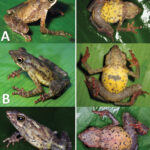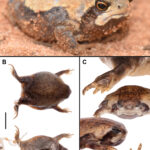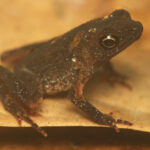- In Search of a Lost Jewel: The Remarkable Story of Atelopus nahumae
- Taxonomy and Classification: Where Does Atelopus nahumae Belong?
- A World of Moss and Mist: The Natural Habitat of Atelopus nahumae
- Dressed to Impress: Physical Characteristics and Unique Adaptations
- From Tadpole to Terrestrial Traveler: Behavior and Life Cycle
- A Crucial Player in its Ecosystem
- Threats and Trials: The Conservation Story
- Cultural and Scientific Relevance
- A Call to Conservation: Protecting the Jewel of the Sierra Nevada
In Search of a Lost Jewel: The Remarkable Story of Atelopus nahumae#
In Colombia’s lush, densely woven Andean rainforests, hidden among vibrant moss-covered rocks and shaded foliage, lives a small, colorful jewel of the amphibian realm—Atelopus nahumae. Known locally as the Nahuma Harlequin Frog, this diminutive amphibian possesses an undeniable charisma that draws the attention of scientists and conservation enthusiasts alike. Belonging to a family renowned for vibrant colors, bold patterns, and unfortunately, alarming vulnerability, Atelopus nahumae has become emblematic of the delicate balance of ecosystems and the urgent need for conservation awareness.
Yet, the story of Atelopus nahumae is far from simple. Long thought extinct, this spectacular frog has recently re-emerged, igniting both hope and caution within conservation circles. As we dive deeply into its mysterious life within the Andean cloud forests, we will unravel its fascinating biology, unique ecological niche, and the conservation challenges it faces—while weaving a narrative that underscores the fragile interconnectedness of life on our planet.
Taxonomy and Classification: Where Does Atelopus nahumae Belong?#
Understanding Atelopus nahumae begins with its scientific framework. Classified within the Amphibia class and Anura order, this frog is part of the family Bufonidae—a diverse family commonly referred to as “true toads.” But Atelopus stands apart, known as “harlequin frogs,” a vibrant, distinctively colored genus often confused with poison dart frogs of another family—but no less spectacular.
The genus name “Atelopus” translates roughly to “imperfect foot,” referring curiously to their slender, elongated limbs, well-adapted for navigating rocky stream banks and leaf litter. First described scientifically in the late 20th century, Atelopus nahumae has been cataloged among dozens of sister species scattered throughout Central and South America, each uniquely adapted to their respective habitats.
Yet remarkably little was known about A. nahumae before the alarming decline in its populations. The species’ initial observation, description, and subsequent rediscovery represent vital chapters in our understanding and acknowledgment of biodiversity hidden in remote corners of our planet.
A World of Moss and Mist: The Natural Habitat of Atelopus nahumae#
To imagine Atelopus nahumae in its natural setting, one must envision the evocative misty slopes of Colombia’s Sierra Nevada de Santa Marta—a biodiversity hotspot unlike anywhere else on earth. Here, the air hangs cool and humid, constantly caressed by moisture-laden winds swirling among lush vegetation. Trees dripping with lichens and orchids rise over thickets of ferns, mosses carpet ancient stone surfaces, and tiny streams trickle down steeply sloping terrains. In these streams and beneath surrounding foliage lives our amphibious protagonist.
Highly specialized in habitat preference, Atelopus nahumae favors pristine, fast-moving mountain streams interwoven within dense, humid forests. Within these precious ecosystems, every detail matters: clear, unpolluted water ensures qualified spawning grounds, while leaf litter and mossy rocks offer cover and generous hunting grounds for small insects that constitute the frog’s primary diet.
This habitat specificity, while beautiful and poetic to ponder, unfortunately leaves Atelopus highly vulnerable. Any subtle shift—whether through climatic changes, agricultural expansion, deforestation, or pollution—can dramatically alter the delicate balance required for their survival, making these montane forests more than a backdrop: they become the critical lifeline sustaining the existence of this rare species.
Dressed to Impress: Physical Characteristics and Unique Adaptations#
The tiny Atelopus nahumae measures just a few centimeters in length, yet its physical presence demands immediate admiration. Its sleek body and elongated limbs portray an amphibian built for agility, navigating with grace and ease through complex terrain. Its smooth skin and enchanting coloration—combinations of shiny blacks, sharp yellows, deep greens, and bold oranges—aren’t just for aesthetic appeal but serve critical ecological purposes.
The bold coloration carries a potent message to predators. Known as aposematic coloration, the vivid shades unmistakably caution would-be predators against harm—warning of underlying toxins embedded within the frog’s delicate skin. These biologically produced chemicals offer a potent defense against predators, providing a fragile frog—with no claws or fangs— an extraordinary evolutionary advantage.
The vibrant coloration is not solely defensive. These distinctive markings also assist in crucial species recognition during breeding seasons, signaling readiness to potential mates. Coloration patterns subtly differ between individuals and sexes, creating intriguing distinctions scientists are still unpacking.
From Tadpole to Terrestrial Traveler: Behavior and Life Cycle#
A Life Cycle of Intrigue and Adaptation#
Atelopus nahumae’s entire life cycle is intrinsically tied to the streams coursing through its habitat. With the arrival of rainy conditions, males gather along bank-side vegetation and rocks, producing vocalizations that echo like chirps through dense foliage. These mating calls, subtle and high-pitched, lead females cautiously toward suitable spawning sites within pristine flowing waters.
Following successful courtship, females deposit strings of delicate eggs beneath submerged rocks or on vegetation along streams. These eggs hatch into small, somewhat inconspicuous tadpoles, gently grazing on algae and detritus present along the submerged surfaces.
During metamorphosis, a remarkable transition transforms the tadpole from an aquatic creature with gills into an air-breathing adolescent frog capable of terrestrial life. At this point, juveniles adopt terrestrial behaviors, moving carefully among mossy stones and canopy shadows to find scaled-down versions of adult hunting grounds.
Feeding Strategies of a Rainforest Opportunist#
The adult Atelopus nahumae becomes an efficient insectivore, seizing delicate prey like tiny crickets, ants, and fruit flies using its keen eyesight and startlingly accurate tongue. Predation opportunities are plentiful among these richly complex microhabitats offering both camouflage and abundant prey.
A Crucial Player in its Ecosystem#
Atelopus nahumae exemplifies the essential ecological niche amphibians occupy within tropical ecosystems. They serve both as predator and prey, an important biological control for insect populations, and a significant food source for larger reptiles, birds, and occasionally small mammals. Their dual existence between aquatic and terrestrial phases further underlines their vital ecological roles—connecting multiple layers within their habitat.
Just as significantly, Atelopus species are sensitive bioindicators, quickly reacting to environmental stressors. Changes in their wellbeing can warn scientists of subtle environmental alterations invisible to human eyes, emphasizing their invaluable status in conservation sciences.
Threats and Trials: The Conservation Story#
Tragically, for decades it was believed Atelopus nahumae had vanished entirely. Driven to “Critically Endangered” status on the IUCN list by habitat deterioration, pollution, expanding agriculture, and climate change devastation compounded by diseases like chytridiomycosis fungus, hope faded. Recent rediscoveries, though rare and tenuous, mark powerful symbols of hope and possibility. However, these precious sightings have also heightened urgency for immediate conservation actions to safeguard wild habitats and restore healthy populations.
Conservation groups in Colombia now vigorously establish conservation priorities that include habitat protection, controlled breeding programs, and disease control strategies, supported by breeding programs aimed at eventually restocking certain areas. Encouragingly, this combined effort aims to pull Atelopus nahumae back from extinction’s doorstep—challenging an uncertain future with renewed dedication and empathy.
Cultural and Scientific Relevance#
Atelopus nahumae and its relatives resonate deeply in Andean cultures as symbolic beings of purity, ecological harmony, and biodiversity health. Historically, indigenous communities revered these brightly colored amphibians, interpreting their presence or disappearance as messages reflecting wider ecological issues.
Scientifically, A. nahumae serves as a critical focus within herpetology studies, offering insights into biodiversity dynamics, environmental sensitivity, and amphibian adaptation capabilities. Ongoing research continues to glean important information about ecosystem interconnectivity and how to respond effectively to amphibian population declines globally.
A Call to Conservation: Protecting the Jewel of the Sierra Nevada#
Learning about Atelopus nahumae compels us to reflect on our interconnected ecological world. The return of this remarkable frog—fragile, beautiful, yet resilient—reminds us that conservation efforts, however challenging, can yield inspiring victories.
Protecting ecosystems vital to Atelopus nahumae ensures not just this one vibrant amphibian species’ survival but the preservation of immeasurable biodiversity and stability for future generations. You can actively engage in these ongoing conservation stories—participate through local conservation groups, support natural reserves, or educate others.
After all, every ecosystem’s jewel, large or small, deserves a fight on its behalf, preserving our world’s natural treasures like Atelopus nahumae for countless generations yet to come.















